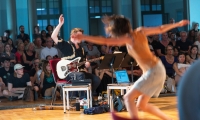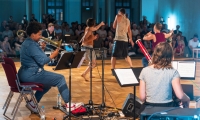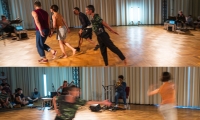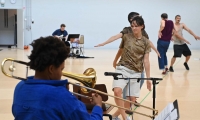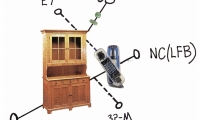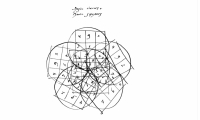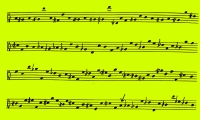A dance-music matrix inspired by Anne Teresa De Keersmaeker and Anthony Braxton’s scores
Kobe Van Cauwenberghe
musical leader
Marie Goudot, Michaël Pomero, Sophia Dinkel, Mark Lorimer
creative movement team

Dancers
Sophia Dinkel
Marie Goudot (except in Bern)
Robin Haghi (in Oslo and Bern)
Mark Lorimer (except in Oslo)
Michaël Pomero

Ictus musicians
Nabou Claerhout, trombone,
Jean-Luc Plouvier, keyboard
Kobe Van Cauwenberghe, e-guitar
Lucas Messler, percussion (except in Bern)
Dirk Descheemaeker, clarinet (in Bern)

BERN guest musicians
Silke Strahl, saxophone
Jan-Filip Tupa, cello

Previous project participants
Natali Abrahamsen Garner, vocals and electronics (Oslo)
Signe Emmeluth, saxophone (Oslo)
Niels Van Heertum, euphonium, trumpet (Darmstadt, Barcelona)
Katie Young, bassoon (Darmstadt)
Andreas Borregaard, accordion (Darmstadt)
Sarah Claman, violin (Barcelona)
Anita Cappuccinelli, percussion (beta-tester)
Marina Delicado, keyboard (beta-tester)
Leonardo Melchionda, e-guitar (beta-tester)
Maris Pajuste, voice (beta-tester)

Production
Produced by Ictus and Rosas
With the support of Tax Shelter of the Belgian Federal Government
ANTHONY BRAXTON
Born 1945, Anthony Braxton has played a key role in contemporary and avant-garde-music as a composer, multi-instrumentalist (saxophonist ... and more), music theorist, teacher and mentor. Inspired by jazz, European music, and music of other cultures, Braxton labels his output Creative Music. He has been an important member of the legendary AACM, Association for the Advancement of Creative Musicians, founded in 1965 in Chicago. Originally formed as an organization to help struggling musicians find work, AACM became world renowned for their unique conception of music, jazz, and improvisation. Through their musical activities they also addressed the social concerns of their community.
As an instrumentalist, Braxton recorded numerous highly influential albums and published his extensive musical philosophy in the three-volume Tri-Axium Writings and five-volume Composition Notes. As a composer, Braxton has written more than 500 works to date, ranging from solo music, small and large ensembles, 100 tubas, orchestra, multiple orchestra and the unfinished 12-movement opera cycle Trillium.

GHOST TRANCE MUSIC: TITLE EXPLANATION
In the early ’90s, Anthony Braxton attended several classes on Native American music at Wesleyan University, where he taught. More specifically, the classes centred on a post-colonial ritual of the late nineteenth century called Ghost Dance, in which different Native American tribes came together to make contact with their eradicated ancestors in hour-long circle dances or Ghost Dances. These experiences had a great impact on Braxton and were an important inspiration for what would become Ghost Trance Music.
« A MUSICAL SUPER-HIGHWAY »
Violinist Erica Dicker described Ghost Trance Music as
a musical super-highway – a meta-road – designed to put the player in the driver's seat, drawing his or her intentions into the navigation of the performance, determining the structure of the performance itself.
The huge score of Ghost Trance has to be considered as a toolbox. Performers can select and overlay different sub-compositions, adding improvisation, surprising each other, creating sub-groups of musicians. Music must be different every time.
THE PRIMARY MELODY (about the word trance)
The very core of the composition has been simply called primary melody. The primary melody consists of a continuous series of notes without any rhythmic variation. The melody is played in unison within a regular pulse resembling a trance beat, that seemingly continues without end: the ritual and ceremonial aspect is an essential part of the piece.
TRANSIDIOMATIC AND MULTIHIERARCHIC
According to Kobe Van Cauwenberghe, Flemish guitarist who coached the workshops on Ghost Trance Music for Ictus and P.A.R.T.S in 2021, the piece must be described as transidiomatic,
a unique platform for musicians to come together from a variety of backgrounds; where each individual's input determines the course and the common experience of the performance. Another term Braxton regularly uses is multi-hierarchical, which refers to how decisions in his music can always be made on different levels, undermining the traditional hierarchy between composer, score, conductor and performer.
WORKING WITH GHOST TRANCE MUSIC
The aura of the score, the efficiency of the rules provided by Braxton are so strong, that the musicians have realized during the Ictus workshops that only a small amount of rehearsals were necessary. New musicians with unexpected instruments, or last minute guests, are easy to integrate into the basic set.
The idea is to constitute a “matrix group” of 4 dancers and 4 musicians, overtrained to play with all possible combinations inside Ghost Trance Music, and to organise rehearsals in different cities, with local guests, in a very inclusive and transidiomatic spirit. The rehearsals culminate in public performances.
Braxton's multi-hierarchical and transidiomatic 'super-formalism' is to be appropriated by the musicians in a playful spirit—with humour and fantasy. At the end of the long text that sets out the rules of the game "Ghost Trance Music", Braxton is careful to specify:
Have fun with this material and don't get hung up with any one area. [...] Don't misuse this material to have only "correct" performances without spirit or fun. [...] Each performance must have something unique. [... Finally, I recommend as few rehearsals as possible so that everyone will be slightly nervous. (!)
TOOLBOX
In 2022, Anne Teresa De Keersmaeker entrusted Marie Goudot, Michaël Pomero, Cynthia Loemij and Mark Lorimer with a 'Rosas ToolBox' laboratory, originally conceived as an educational project. Rather than passively archiving the company's work, the ‘Rosas ToolBox’ develops a concept of creative documentation: to make an inventory of the choreographic dictionary used by, or developed in the work of De Keersmaeker and Rosas, the formal tools, the recurring combinatory processes, etc.—and to make them available to everyone, so that they can be experienced in the present.
Despite the difference in aesthetic qualities, Braxton's and De Keersmaeker's ‘Super-Formalisms’ have so much in common! Both do not aim to moderate human energies, to rationalise our relationship to art or to create rigid categories—but on the contrary to set human creativity on fire through combinatory strategies. Inventing provisional categories, drawing their map, giving them metaphorical or playful names, connecting them to each other, testing new operations, and finally interpreting the present in them as in a Zodiac: this is the game, the Great Game, shared by both artists.

ANTHONY BRAXTON
Anthony Braxton, geboren in 1945, speelde een sleutelrol in de hedendaagse en avant-garde-muziek als componist, multi-instrumentalist (saxofonist ... en meer), muziektheoreticus, leraar en mentor. Braxton beschrijft zijn output als Creative Music en haalt inspiratie uit jazz, Europese muziek en muziek van andere culturen. Hij was een belangrijk lid van de legendarische AACM, Association for the Advancement of Creative Musicians. Opgericht in 1965 in Chicago als een organisatie om muzikanten in moeilijkheden aan werk te helpen, werd AACM wereldberoemd door hun unieke opvatting over muziek, jazz en improvisatie. Via hun muzikale activiteiten richtten ze zich ook op de sociale problemen van hun gemeenschap.
Braxton nam als instrumentalist talrijke zeer invloedrijke albums op en publiceerde zijn uitgebreide muzikale filosofie in het driedelige Tri-Axium Writings en vijfdelige Composition Notes. Als componist schreef Braxton tot op heden meer dan 500 werken, variërend van solomuziek, kleine en grote ensembles, 100 tuba's, orkest, multiple orchestra en de nog onvoltooide 12-delige operacyclus Trillium.

Ghost Trance Music: origins
Begin jaren '90 volgde Anthony Braxton een aantal lessen over inheemse Amerikaanse muziek aan de Wesleyan University, waar hij doceerde. Meer specifiek gingen de lessen over een postkoloniaal ritueel uit de late negentiende eeuw, Ghost Dance genaamd, waarin verschillende inheemse stammen samenkwamen om contact te maken met hun uitgeroeide voorouders in urenlange kringdansen of Ghost Dances. Deze ervaringen hadden een grote impact op Braxton en vormden een belangrijke inspiratiebron voor wat Ghost Trance Music zou worden.
« A MUSICAL SUPER-HIGHWAY »
Violiste Erica Dicker beschreef Ghost Trance Music als:
a musical super-highway – a meta-road – designed to put the player in the driver's seat, drawing his or her intentions into the navigation of the performance, determining the structure of the performance itself.
De grote hoeveelheid aan Ghost Trance Music composities kunnen worden beschouwd als een toolbox. Performers kunnen verschillende subcomposities selecteren en overlappen, improvisatie toevoegen, elkaar verrassen, subgroepen van muzikanten creëren. De muziek moet elke keer anders zijn.
THE PRIMARY MELODY (OVER HET WOORD TRANCE)
De kern van de compositie bestaat uit een zogeheten primary melody. Deze primaire melodie bestaat uit een ononderbroken reeks noten zonder enige ritmische variatie. De melodie wordt unisono gespeeld binnen een regelmatige puls die lijkt op een trancebeat en schijnbaar zonder einde doorgaat: het rituele en ceremoniële aspect is een essentieel onderdeel van het stuk.
TRANS-IDIOMATISCH AND MULTI-HIERARCHISCH
Volgens Kobe Van Cauwenberghe, Vlaams gitarist die in 2021 de workshops Ghost Trance Music voor Ictus en P.A.R.T.S. coachte, kan je GTM beschrijven als transidiomatisch:
een uniek platform voor muzikanten om samen te komen vanuit verschillende achtergronden; waarbij ieders inbreng het verloop en de gemeenschappelijke ervaring van de uitvoering bepaalt. Een andere term die Braxton regelmatig gebruikt is multi-hiërarchisch, wat verwijst naar hoe beslissingen in zijn muziek altijd op verschillende niveaus kunnen worden genomen, waardoor de traditionele hiërarchie tussen componist, partituur, dirigent en uitvoerder wordt ondermijnd.

WORKING WITH GHOST TRANCE MUSIC
De aura van de partituur en de efficiëntie van de door Braxton aangereikte regels zijn zo sterk, dat de musici zich tijdens de Ictus-workshops realiseerden dat slechts een klein aantal repetities nodig was. Nieuwe musici met onverwachte instrumenten, of last-minute gast musici zijn gemakkelijk te integreren in de basisset.
Het idee is om een "matrixgroep" te vormen van 4 dansers en 4 muzikanten, getraind om te spelen met alle mogelijke combinaties binnen Ghost Trance Music, en repetities te organiseren (van korte of middellange duur) in verschillende steden, met lokale gasten, in een zeer inclusieve en transidiomatische geest. De repetities worden afgesloten met publieke optredens.
De musici worden aangemoedigd om Braxtons multi-hiërarchische en transidiomatische "superformalisme" in een speelse geest - met humor en fantasie - te interpreteren. Aan het eind van zijn instructieve tekst “Introduction to Catalog of Work”, preciseert Braxton zorgvuldig:
Have fun with this material and don't get hung up with any one area. [...] Don't misuse this material to have only "correct" performances without spirit or fun. [...] Each performance must have something unique. [... Finally, I recommend as few rehearsals as possible so that everyone will be slightly nervous. (!)

TOOLBOXES
In 2022 vertrouwde Anne Teresa De Keersmaeker Marie Goudot, Michaël Pomero, Cynthia Loemij and Mark Lorimer een laboratorium 'Rosas ToolBox' toe. In plaats van het werk van het gezelschap passief te archiveren, ontwikkelt de 'Rosas ToolBox' een concept van creatieve documentatie: een inventaris maken van het choreografisch woordenboek dat De Keersmaeker en Rosas hebben ontwikkeld, de formele tools, de terugkerende combinatorische processen, etc. - en ze voor iedereen beschikbaar maken, zodat ze ook in het heden kunnen worden beleefd.
Ondanks het verschil in esthetische kwaliteiten hebben de "superformalismen" van Braxton en De Keersmaeker zoveel gemeen! Beiden hebben niet tot doel menselijke energieën te temperen, onze relatie tot kunst te rationaliseren of rigide categorieën te creëren, maar integendeel de menselijke creativiteit aan te wakkeren door middel van combinerende strategieën. Het uitvinden van imaginaire categorieën, ze in kaart brengen, ze metaforische of speelse namen geven, ze met elkaar verbinden, nieuwe operaties uitproberen en tenslotte het heden erin interpreteren als in een Zodiac: dat is het spel, het Grote Spel, dat beide kunstenaars delen.
ANTHONY BRAXTON
Né en 1945, Anthony Braxton a joué un rôle clé dans la musique contemporaine et la culture d'avant-garde en tant que compositeur, multi-instrumentiste (saxophoniste, entre autres — mais pas que !), théoricien, professeur et curateur. Inspiré par le jazz, la musique européenne et bien d'autres cultures, Braxton a subsumé sa production sous le nom de Creative Music. Il a été un membre important de l'AACM, Association for the Advancement of Creative Musicians, fondée en 1965 à Chicago. Formée à l'origine pour aider les musiciens en difficulté à trouver du travail, l'AACM a gagné sa célébrité pour sa conception unique de la musique et de l'improvisation. Tout en changeant le visage du free jazz, les musiciens de l'AACM élargissaient leur champ d'action et s'attaquaient par ailleurs aux problèmes de leur communauté.
Braxton a publié une vaste somme de philosophie musicale dans les trois volumes Tri-Axium Writings et les cinq volumes des Composition Notes. À ce jour, il a composé plus de 500 œuvres, allant de la musique en solo aux petits et grands ensembles, en passant par des œuvres pour cent tubas, plusieurs orchestres et un cycle d'opéra en 12 parties, Trillium, toujours inachevé à ce jour.

GHOST TRANCE MUSIC : EXPLICATION DU TITRE
Au début des années 90, Anthony Braxton suivit une série de cours sur la musique amérindienne à l'université Wesleyan, où il enseignait. Plus précisément, ces cours portaient sur un rituel post-colonial de la fin du XIXe siècle appelé Ghost Dance, au cours duquel différentes tribus de Natifs américains se réunissaient pour entrer en contact avec leurs ancêtres éradiqués, à travers des sessions de danses en cercle d'une heure, Ghost Dances. Ces expériences ont eu un impact considérable sur Braxton et ont été une source d'inspiration importante pour ce qui allait devenir la Ghost Trance Music.
" A MUSICAL SUPER-HIGHWAY " (UNE AUTOROUTE MUSICALE)
La violoniste Erica Dicker a décrit Ghost Trance Music en ces termes :
une autoroute musicale - une hyper-route - où chaque musicien est invité sur le siège du conducteur. Ses intentions sont intégrées dans la navigation de la performance, et en déterminent la structure. L'immense partition de Ghost Trance doit être considérée comme une boîte à outils. Les interprètes peuvent sélectionner et superposer différentes sous-compositions, en ajoutant de l'improvisation, en se surprenant les uns les autres, en créant des sous-groupes de musiciens. La musique peut et doit être différente à chaque fois.
La mélodie principale (à propos du mot trance)
Au cœur de la composition de trouve ce que Braxton nomme la mélodie primaire. La mélodie primaire consiste en une série continue de notes obstinées, sans aucune variation rythmique. La mélodie est frappée à l'unisson au gré d'une pulsation régulière ressemblant à un rythme de transe, potentiellement infini : l'aspect rituel et cérémoniel est une partie essentielle de la pièce.
TRANSIDIOMATIQUE ET MULTIHIÉRARCHIQUE
Selon Kobe Van Cauwenberghe, le guitariste flamand qui a encadré les ateliers sur la Ghost Trance Music pour Ictus et P.A.R.T.S en 2021, la pièce peut être décrite comme transidiomatique :
Une plateforme unique pour des musiciens venant d'horizons différents, où l'apport de chacun détermine le déroulement et l'expérience commune de la performance. Un autre terme possible, que Braxton utilise volontiers, est multi-hiérarchique : ceci fait référence à la façon dont les décisions concernant sa musique peuvent toujours être prises à différents niveaux simultanés, sapant la hiérarchie traditionnelle entre le compositeur, la partition, le chef d'orchestre et l'interprète.
TOOLBOX
En 2022, Anne Teresa De Keersmaeker confiait à Marie Goudot, Michaël Pomero, Cynthia Loemij et Mark Lorimer un laboratoire « Rosas ToolBox », pensé" au départ comme un projet pédaggogique. Plutôt que d’archiver passivement le travail de la compagnie, la « Rosas ToolBox » prend le parti d’une « documentation créative » : recenser diagonalement le lexique chorégraphique utilisé ou développé développé par De Keersmaeker et Rosas, filtrer et classer les outils formels, faire comprendre les procédés combinatoires récurrents… et les rendre disponibles à tous, pour les faire vivre au présent.
SUPER-FORMALISMES
Les « super-formalismes » d’un Braxton ou d’une De Keersmaeker, si différents et pourtant si proches, ne visent pas à modérer les impulsions artistiques, à rationaliser notre pratique créative ou à créer des catégories rigides — mais au contraire à mettre le feu à la créativité humaine par le biais des stratégies combinatoires. Jouer avec les outils, inventer des catégories provisoires, en dresser la carte, leur donner des noms métaphoriques ou ludiques, les brancher l’une sur l’autre, tester de nouvelles opérations — et finalement interpréter le présent comme un Zodiaque : tel est le jeu, le Grand Jeu dont les deux artistes partagent le secret.
TRAVAILLER GHOST TRANCE
L'aura de la partition, l'efficacité des règles fournies par Braxton sont si fortes que les musiciens ont réalisé, durant les workshops d'Ictus, que seul un petit nombre de répétitions était nécessaire. De nouveaux musiciens jouant des instruments inhabituels, ou des invités de dernière minute, sont faciles à intégrer dans le set de base. L'idée est de constituer un "groupe matrice" composé de 4 danseurs et de 4 musiciens, surentraînés à jouer avec toutes les combinaisons possibles au sein de la Ghost Trance Music, et d'ouvrir des ateliers (de courte ou moyenne durée) dans différentes villes, avec des invités locaux, dans un esprit très inclusif et trans-idiomatique. Les ateliers se terminent par des représentations publiques.
N'ABUSEZ PAS !
Le formalisme multi-hiérarchique et trans-idiomatique de Braxton doit être approprié par les musiciens dans une atmosphère ludique, avec humour et fantaisie. À la fin du long texte qui énonce les règles du jeu "Ghost Trance Music", Braxton prend soin de préciser :
Amusez-vous avec ce matériel et ne vous attachez pas telle ou telle partie en particulier. [...] N'abusez pas de ce matériel pour en faire des performances "correctes", dénuées d'esprit ou de plaisir. [...] Chaque représentation doit avoir quelque chose d'unique. [...] Enfin, je recommande de répéter le moins possible afin chacun reste un peu excité.
(LOL) (ce que nous ne faisons pas).

Agenda for this project
- Date Show Location
-
Fri 18.08 Ghost Trance Music | Rosas Toolbox Orangerie — Ferienkurse - Darmstadt - Germany

Ghost Trance Sessions
start: 1930h A dance-music matrix inspired by Anne Teresa De Keersmaeker and Anthony Braxton’s scores read more -
Fri 18.08 Ghost Trance Music | Rosas Toolbox Orangerie — Ferienkurse - Darmstadt - Germany

Ghost Trance Sessions
start: 2130h A dance-music matrix inspired by Anne Teresa De Keersmaeker and Anthony Braxton’s scores read more
- Date Show Location
-
Wed 20.09 Ghost Trance Music | Rosas Toolbox MacBa - Barcelona - Spain

Ghost Trance Sessions
A dance-music matrix inspired by Anne Teresa De Keersmaeker and Anthony Braxton’s scores read more
- Date Show Location
-
Fri 05.09 Ghost Trance Sessions Musikfest - Bern - Switzerland

Ghost Trance Sessions
A dance-music matrix inspired by Anne Teresa De Keersmaeker and Anthony Braxton’s scores read more
